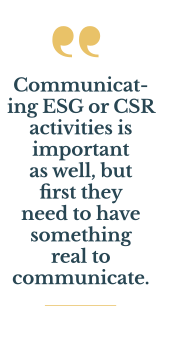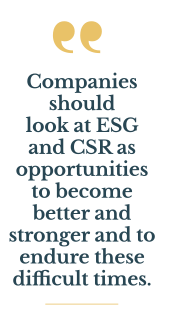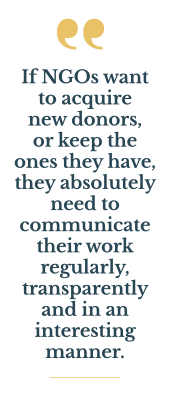From your perspective, how has ESG in Slovakia developed over the past few years?
It would be great to have some hard data on this, so we could see how companies proceed in this area. Unfortunately, we don´t have such complex data related to the development of ESG in Slovakia. Nevertheless, from our experiences with our clients and from the activities we see happening in Slovakia, I feel that the importance of ESG has grown here too. It is a clear trend abroad and Slovakia is catching up as well.
If we look at big corporations, we often see that Slovak branches are developing their ESG based on directions coming from their international headquarters. This, for example, is the case with IKEA or Henkel, with whom we have worked for years and together we have developed various activities falling under their ESG scope.
In what areas do we still lag behind in comparison with Western Europe?
We are definitely still lagging behind in more than one area. The most important one is the quantity of good ESG and CSR in Slovakia. If someone is investing in this, it´s mostly international or big companies that have extra resources. Smaller companies don´t see this as a priority. Another problem is the depth and quality. Not every company realizes that this can´t be just a short-term PR stunt, but they need to go deeper.
 However, I do understand some of the companies, for which this is not a priority. They often have problems to stay alive and not sink in these turbulent times. We are facing one crisis after another – we barely started to come out of the pandemic, and we found ourselves on the borders of a war and at the beginning of a huge energetic and financial crisis. But even this situation can be seen as an opportunity. The pandemic brought many unexpected developments for companies – it strengthened and moved forward their digitalization, remote work became more accessible, and we saw development in work-life balance. Companies should look at ESG and CSR as opportunities to become better and stronger and to endure these difficult times.
However, I do understand some of the companies, for which this is not a priority. They often have problems to stay alive and not sink in these turbulent times. We are facing one crisis after another – we barely started to come out of the pandemic, and we found ourselves on the borders of a war and at the beginning of a huge energetic and financial crisis. But even this situation can be seen as an opportunity. The pandemic brought many unexpected developments for companies – it strengthened and moved forward their digitalization, remote work became more accessible, and we saw development in work-life balance. Companies should look at ESG and CSR as opportunities to become better and stronger and to endure these difficult times.
You also have experience from the NGO sector. Are Slovak NGOs getting better at communicating their mission?
Definitely. Just a few years ago, most NGOs didn´t realize the importance of communication and PR activities. Many of them saw it as a burden and even as unnecessary bragging. Today, the situation is quite different. Many of them have at least one employee responsible for communication and fundraising, some have whole teams dedicated to communicating their mission and activities. Our NGO market is not that big, many of them know each other and started to learn from each other´s experience.
Many NGOs need or are even dependent on individual donors, most importantly the regular ones. If they want to acquire new donors, or keep the ones they have, they absolutely need to communicate their work regularly, transparently and in an interesting manner.
Are they still too dependent on public funds, or are they also looking for other opportunities, such as crowdfunding or partnering with private companies?
I don´t think I can define that in general, but I will speak from our experience. And from our experience, most of the NGOs are still dependent on public funds. If this funding gets cut, or they don´t get it at all, they can find themselves in very difficult situations. Therefore, they are actively trying to build a more stable base of individual donors, and some are also trying to acquire major donors and supporters. However, major donor fundraising is not an easy task, especially in our small Slovak market. Many companies are already supporting specific NGOs and they don’t want to replace them and can´t afford to add new ones. Additionally, as I mentioned before, not enough companies are investing in ESG and CSR yet.
 What led to the creation of the Social Impact Team at Seesame?
What led to the creation of the Social Impact Team at Seesame?
Social impact is in our DNA from the beginning. We have always felt strongly about contributing to the world we live in – either through helping civil society, supporting science and research, fighting against disinformation or through encouraging our clients to be brave and publicly stand up for what´s right. We always thought about the social impact and the wider context of our clients´ activities and step by step we also started working on purely social impact campaigns as well. One of the first big social impact campaigns we carried out was the Land of Saviours, a series of online first aid courses, that we created for Pfizer, in cooperation with the Slovak Red Cross and Viliam Dobiáš, a legendary Slovak rescuer. Activities and campaigns slowly piled up and in 2018 we decided to create a team dedicated specifically to social impact.
What are the key elements of a good ESG communication strategy?
I would say this very simply – there has to be a balance between what the company does and says. ESG is becoming quite the buzzword in the business world, in media and between consumers. But companies shouldn´t just jump on this trend with isolated activities that aren´t sincere, nor believable. In addition, if a company is damaging the community in which it operates, it can act as a philanthropist as much as it wants, even carry out real aid and genuinely beneficial activities, but the moment the public finds out about what the company is doing with its other hand, nobody will believe its ESG anymore.
Companies should genuinely and realistically look at their impact in all three areas of ESG – they should consider their impact on the environment, communities and the society, as well as on their relationship to their own employees and their governance. This is where they should start – with real actions that will reduce their negative impact and support positive development in a believable way. And then they can also communicate it, because let´s be honest – if they didn´t, nobody would find out about it. Communicating ESG or CSR activities is important as well, but first they need to have something real to communicate.
 Are clients from the private sector willing to invest the time and resources into long-term commitments or are they looking for fast results?
Are clients from the private sector willing to invest the time and resources into long-term commitments or are they looking for fast results?
This depends on every individual company. We have clients who are willing to do that and these are also the ones who are doing it well. For example, we are regularly working with O2, a company that recognizes that the internet data they provide doesn’t have to be used only for good. They have carried out various activities supporting media literacy, critical thinking and fighting disinformation, including their own campaigns, educational activities or financial support for beneficial initiatives and NGOs. We see it also in employer branding, to which we have a whole team dedicated as well. Companies are fighting for talented employees and they have to not only show that they´re a good employer to work for, but also really be one.
How do you perceive the claim that CSR and ESG are just more elaborate PR strategies?
Again, it depends on the company. CSR and ESG, if done right, are beneficial to society and help everyone. However, if companies look at it just as a PR strategy, then it will be only that.
What are the risks of greenwashing in terms of brand reputation?
More and more companies are realizing how closely watched they are – by the public, by media, by investors and potential business partners. With direct and simple access to information, they are finding themselves under the microscope of the public eye. All false or misleading campaigns and activities – be it greenwashing, bluewashing or any other washing – can be discovered and harm their reputation quite seriously. There is various data from research that confirms a direct correlation between the ESG score and consumer behavior (including their trust and support of the brands).
How can organizations support their ESG efforts with factual information in a transparent way?
I think this question already has the answer in it. If companies want to work on their ESG in the right way, they should support their decisions and activities with facts and data. And communicate all of it in a transparent and clear way.
Frédérique Halászová, Head of Social Impact Team at Seesame



Follow us